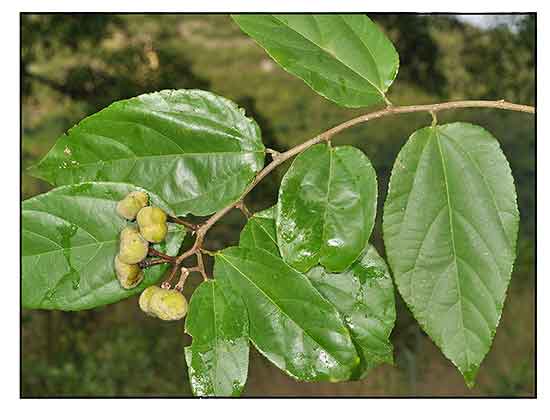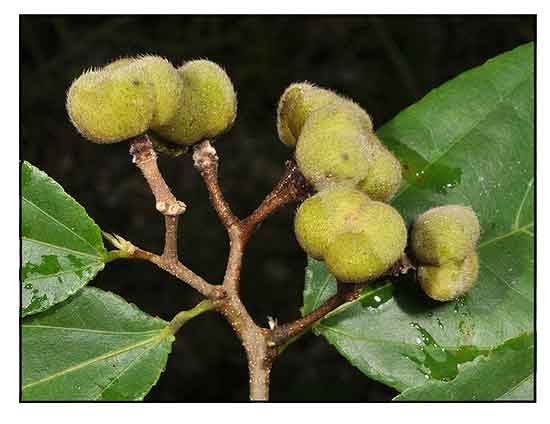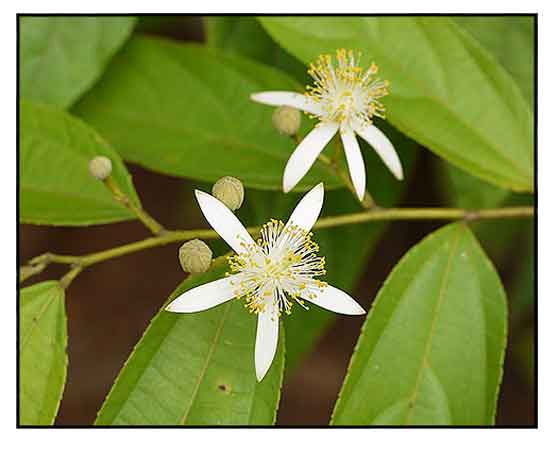
Family • Malvaceae
Talimughat
Alagat
Grewia laevigata Vahl
TWO-LOBED CROSSBERRY
| Scientific names | Common names |
| Grewia laevigata Vahl | Alagat (Iloilo) |
| Grewia mallococa Blanco | Talimughat lingin (Agusan) |
| Grewia multiflora Blanco | Two-lobed crossberry (Engl.) |
| Grewia odorata Blume | |
| Grewia ovalifolia Juss. | |
| Grewia pedicellata Roxb. | |
| Grewia racemosa Noronha | |
| Grewia scabrida Wall. ex Kurz | |
| Grewia umbellata Roxb. ex DC. | |
| Mallococca parva Blanco | |
| Grewia laevigata Vahl is an accepted species. KEW: Plants of the World Online | |
| There is a confusing sharing of synonyms with several Grewia species: Grewia multiflora, G. laevigata, G. serullata, G. sepiaria, etc., along with a confusing sharing and misattribution of common names. | |
| Other vernacular names |
| BANGLADESH: Monsimais, Khing-ar-khial. |
| BORNEO: Akar gerigu, Akar lapit, Karai, Lapion, Sumpit babi, Tanchot.. |
| INDIA: Anekkattimaram, Vallichadachchi. |
| INDONESIA: Simpaling. |
| MALAY: Akar sekapu, Akar sempelas. |
Botany
Properties Parts used Uses Studies Availability |
September 2023
![]()
 |
| PHOTOS / ILLUSTRATIONS |
| OTHER IMAGE SOURCE: Grewia laevigata fruiting twig / Copyright © 2018 by P B Pelser & J F Barcelona (contact: [email protected]) [ref. DOL129205] / Non-Commercial Use / click on image or link to go to source page / Phytoimages.siu.edu |
| OTHER IMAGE SOURCE: Grewia laevigata / Infructescence / Copyright © 2018 by P B Pelser & J F Barcelona (contact: [email protected]) [ref. DOL129158] / Non-Commercial Use / click on image or link to go to source page / Phytoimages.siu.edu |
| OTHER IMAGE SOURCE: Grewia serrulata / Dinesh Valke / CC BY-SA 2.0 / click on image or link to go to source page / Wikipedia |
Additional
Sources and Suggested Readings |
• |
DOI: It is not uncommon for links on studies/sources to change. Copying and pasting the information on the search window or using the DOI (if available) will often redirect to the new link page. (Citing and Using a (DOI) Digital Object Identifier) |
| List of Understudied Philippine Medicinal Plants |
• |
 |


 • Shrub to small tree, up to 10 m high. Leaves oblong-lanceolate, 7–15 by 2.5–5 cm; glabrous or glabrescent; apex cuspidate-acuminate or acute, base obtuse and equal or slightly unequal-sided; margin serrate to serrulate; 3-nerved at base; secondary nerves 4–6 pairs, arched; scalariform veins distinct on lower surface; petioles 5–10 mm long, glabrescent. Inflorescence axillary, very slender and loose or erect 1.5–4 cm long; flower buds oblong, always swollen near base, 4–13 by 2–5 mm. Sepals linear-lanceolate, 10–20 by 1.5–3 mm. Petals oblong, 3–7 by 1.5 mm, glabrous except near base on both surfaces, ciliate along margin. Stamens glabrous. Ovary globose or ovoid, ± 4 by 2 mm, hairy, Fruit rounded , 2–4-lobed, black and woody or dull green and leathery. (Flora of Thailand)
• Shrub to small tree, up to 10 m high. Leaves oblong-lanceolate, 7–15 by 2.5–5 cm; glabrous or glabrescent; apex cuspidate-acuminate or acute, base obtuse and equal or slightly unequal-sided; margin serrate to serrulate; 3-nerved at base; secondary nerves 4–6 pairs, arched; scalariform veins distinct on lower surface; petioles 5–10 mm long, glabrescent. Inflorescence axillary, very slender and loose or erect 1.5–4 cm long; flower buds oblong, always swollen near base, 4–13 by 2–5 mm. Sepals linear-lanceolate, 10–20 by 1.5–3 mm. Petals oblong, 3–7 by 1.5 mm, glabrous except near base on both surfaces, ciliate along margin. Stamens glabrous. Ovary globose or ovoid, ± 4 by 2 mm, hairy, Fruit rounded , 2–4-lobed, black and woody or dull green and leathery. (Flora of Thailand) Distribution
Distribution